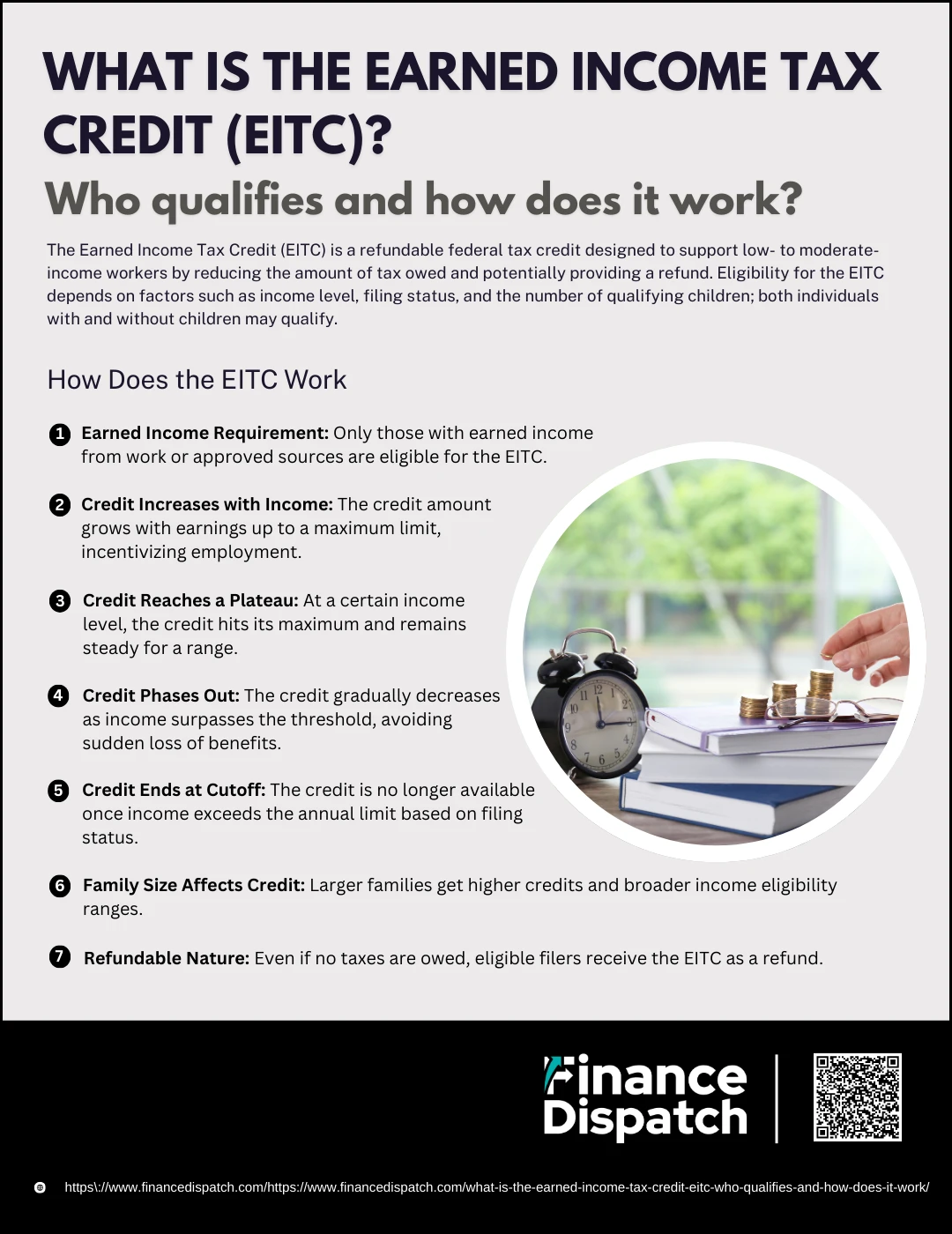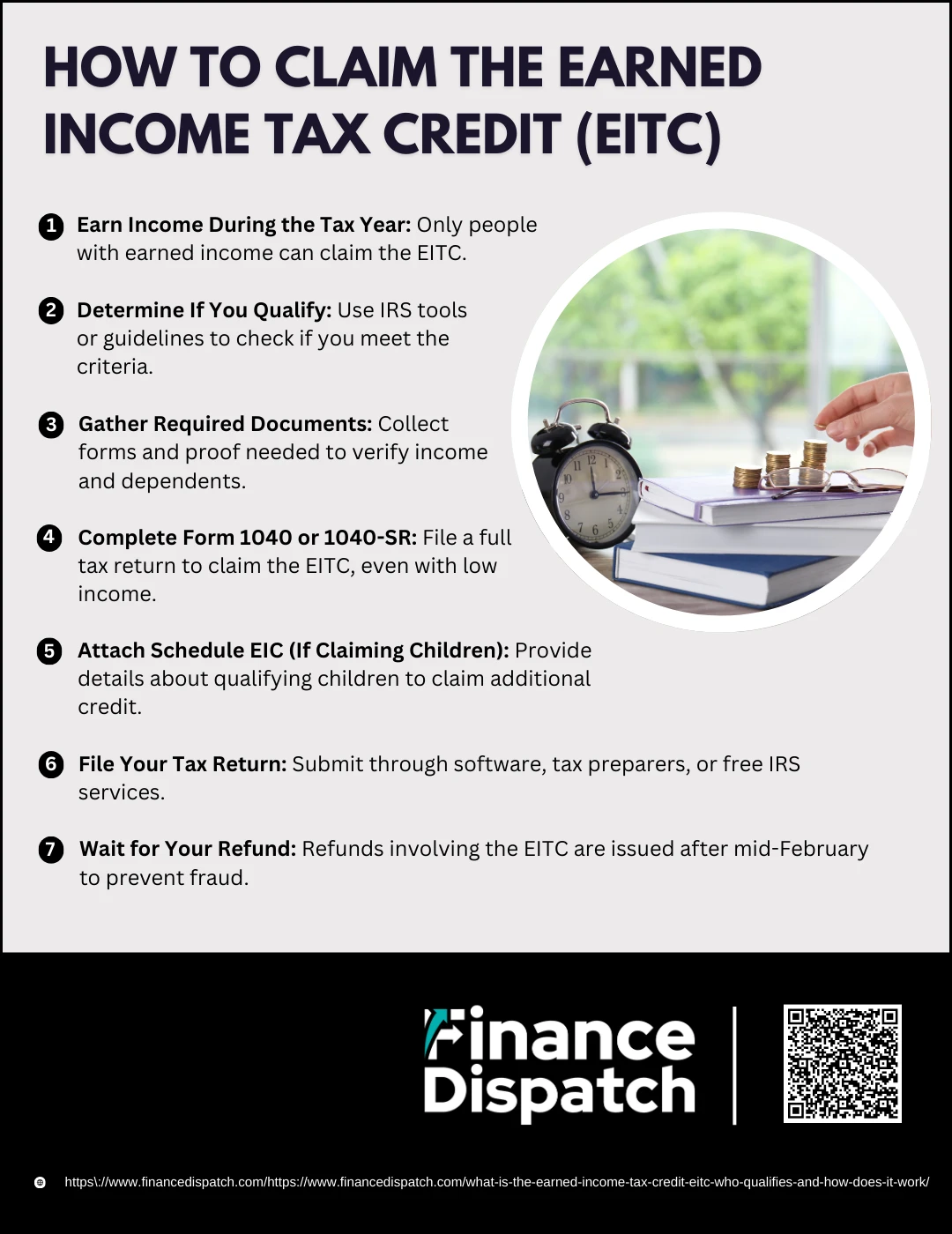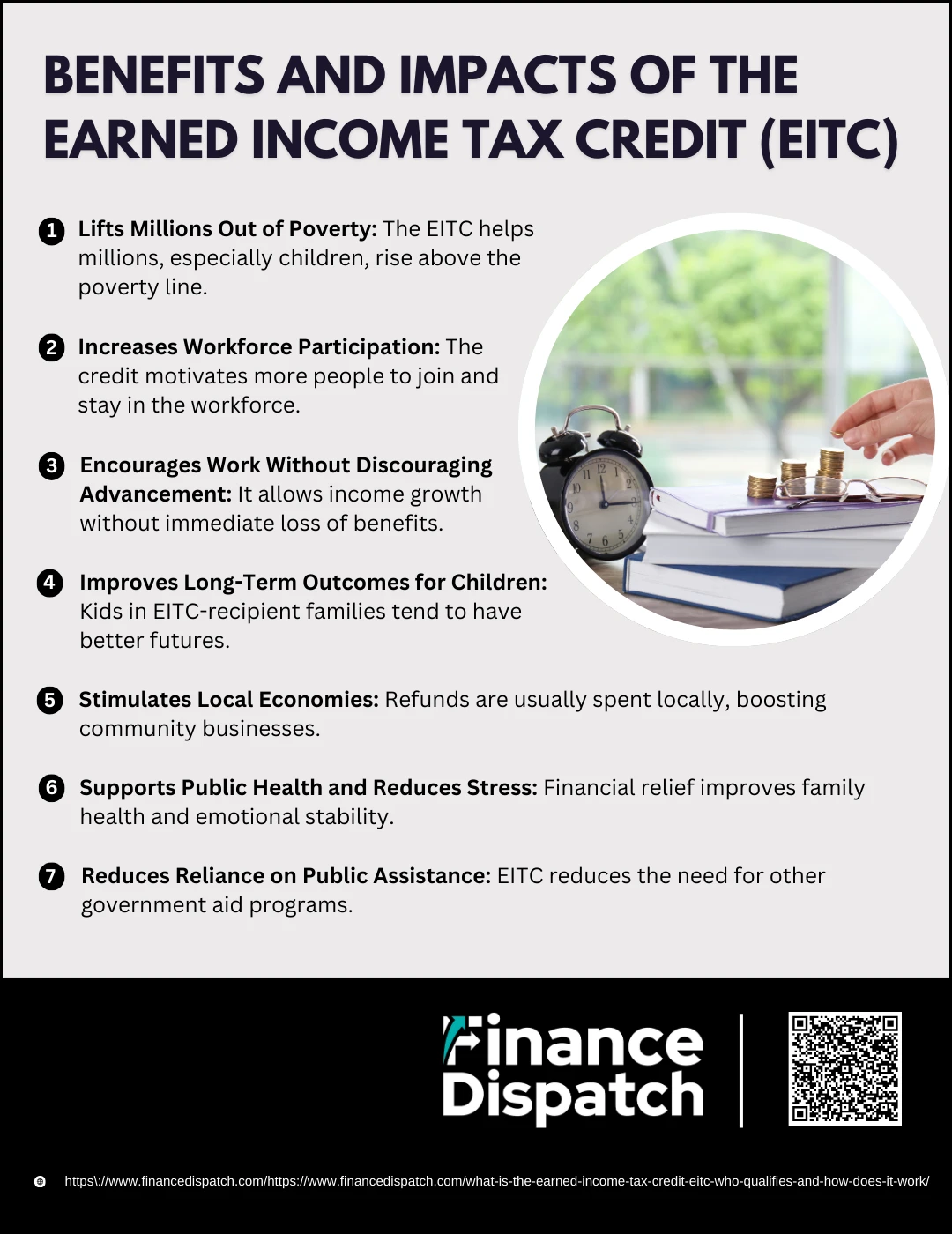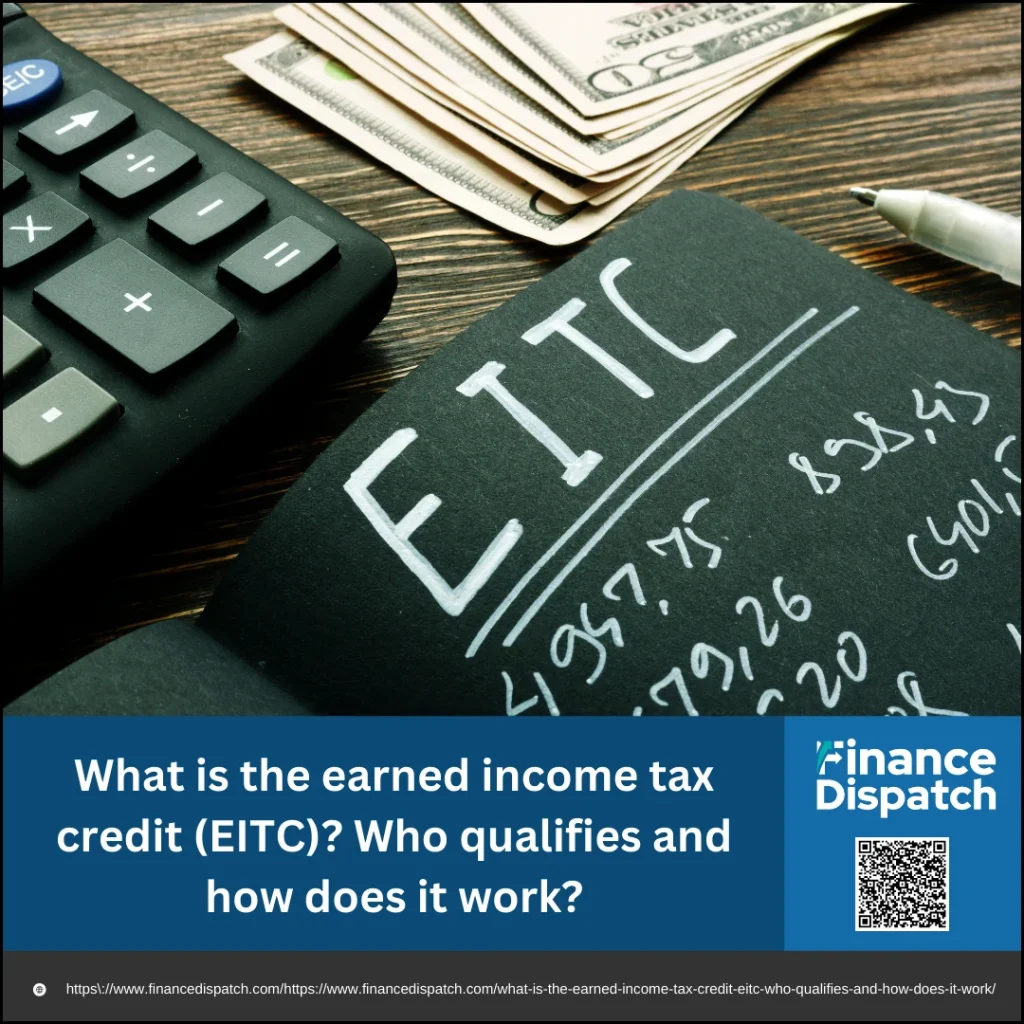The Earned Income Tax Credit (EITC) is one of the most valuable but often overlooked tax benefits available to low- and moderate-income workers in the United States. Created to reduce the financial burden on working families, the EITC not only lowers the amount of tax owed but can also result in a refund—even if no taxes are due. Despite its potential to return thousands of dollars to eligible households, many taxpayers miss out simply because they don’t realize they qualify. In this article, we’ll explore what the EITC is, who is eligible, and how it actually works to support working Americans.
What is the Earned Income Tax Credit (EITC)?
The Earned Income Tax Credit (EITC) is a refundable tax credit designed to support low- and moderate-income individuals and families who earn income through work. Unlike deductions that reduce taxable income, the EITC directly reduces the amount of tax owed and may result in a refund even if no tax is due. The credit amount varies based on income, filing status, and the number of qualifying children, with larger benefits typically going to families with children. Importantly, the EITC incentivizes employment by rewarding earned income, making it a powerful tool for reducing poverty and encouraging workforce participation.
 How Does the EITC Work?
How Does the EITC Work?
The Earned Income Tax Credit (EITC) is structured to reward work and provide financial relief to low- and moderate-income earners. It isn’t just a flat amount given to anyone below a certain income level; instead, the EITC follows a carefully designed formula that adjusts the credit based on earnings and family size. This ensures that the most support goes to those who need it most while still encouraging employment.
1. Earned Income Requirement
To qualify for the EITC, you must have earned income during the tax year. This includes wages, salaries, tips, or earnings from self-employment. It can also include non-taxable combat pay and certain long-term disability benefits. Unearned income such as unemployment benefits, Social Security, investment dividends, or child support does not count. This requirement ensures that the credit supports individuals who are actively working or running a business.
2. Credit Increases with Income
When you begin earning income, the EITC amount starts to increase proportionally. For example, as your income rises from zero, the credit grows at a set percentage—called the phase-in rate—until it reaches the maximum allowable amount. This phase-in incentivizes employment by ensuring that each additional dollar earned increases your credit.
3. Credit Reaches a Plateau
Once your earnings reach a certain range, the EITC hits its maximum credit amount. This plateau means that for a specific income bracket, eligible taxpayers receive the full credit. The range of this plateau depends on the number of qualifying children and your filing status. At this stage, the benefit stabilizes, and additional income doesn’t affect the credit amount—yet.
4. Credit Phases Out
After surpassing the plateau income level, the EITC starts to decrease gradually. This phase-out is triggered once your income exceeds the threshold. For every additional dollar earned, the credit amount is reduced by a fixed percentage until it eventually phases out completely. This gradual reduction helps avoid the “benefit cliff,” ensuring that workers don’t lose the credit abruptly.
5. Credit Ends at Cutoff
Once your income surpasses the upper income limit, the EITC phases out entirely, and you no longer qualify for the benefit. These cutoff points vary each year and depend on filing status and number of dependents. For example, a married couple with three children can earn significantly more than a single individual without children before hitting the cutoff.
6. Family Size Affects Credit
The EITC is highly responsive to family composition. The amount of credit you receive—and the income range over which it is available—is directly influenced by how many qualifying children you claim. Families with more children receive higher maximum credits and face higher income phaseout thresholds. Those without children receive a smaller benefit and must meet additional age requirements.
7. Refundable Nature
The EITC is a refundable tax credit, which means it can provide a refund even if you owe no income tax. For example, if your total tax bill is $0 but you qualify for a $3,000 EITC, you will receive that full $3,000 as a refund. This refundability makes the EITC especially powerful in helping working families meet basic expenses, catch up on bills, or save for future needs.
Who Qualifies for the EITC?
Millions of Americans are eligible for the Earned Income Tax Credit (EITC), but many miss out simply because they don’t realize they qualify. The credit is available to both individuals and families who meet certain income, age, and residency requirements. While having children can significantly increase your credit amount, it’s not a requirement to claim the EITC. To qualify, you must meet several key criteria set by the IRS.
Here are the main requirements for EITC eligibility:
1. Earned Income: You must have earned income from employment, self-employment, or other qualifying sources during the tax year.
2. Adjusted Gross Income (AGI) Limits: Your AGI must fall below the thresholds based on your filing status and number of qualifying children.
3. Valid Social Security Number: You, your spouse (if filing jointly), and any qualifying children must have valid Social Security numbers by the tax filing deadline.
4. U.S. Citizenship or Residency: You must be a U.S. citizen or resident alien for the entire tax year.
5. Investment Income Limit: Your investment income must not exceed $11,600 for the 2024 tax year.
6. Filing Status Restrictions: You cannot use the “Married Filing Separately” status and still claim the EITC.
7. Age Requirement for Childless Claimants: If you do not have qualifying children, you must be between 25 and 64 years old by the end of the year.
8. Not a Dependent: You cannot be claimed as a dependent or qualifying child on another person’s tax return.
9. Residency Requirement (Without Children): If claiming the EITC without children, you must have lived in the U.S. for more than half of the tax year.
Claiming the EITC with or without Children
The amount of Earned Income Tax Credit (EITC) you may receive depends significantly on whether you have qualifying children. Taxpayers with children typically receive a larger credit, while those without children can still qualify—though the benefit is smaller and subject to stricter eligibility rules. Understanding the differences in how the EITC applies to families versus individuals without dependents can help ensure you don’t miss out on valuable tax relief.
Here is a comparison of EITC eligibility and benefits with and without children:
| Criteria | With Qualifying Children | Without Qualifying Children |
| Maximum Credit (2024) | Up to $7,830 (for 3 or more children) | Up to $632 |
| Eligibility Age | No age restriction | Must be between 25 and 64 |
| Residency Requirement | Child must live with you for more than half the year | You must live in the U.S. for more than half the year |
| Filing Status | Most statuses allowed (except Married Filing Separately) | Same |
| Qualifying Dependent | Child must meet age, relationship, and residency tests | Cannot be claimed as a dependent or qualifying child |
| Investment Income Limit (2024) | Less than $11,600 | Same |
| Income Thresholds (2024) | Up to $66,819 (married with 3+ children) | Up to $25,511 (married filing jointly) |
| Additional IRS Form Required | Schedule EIC (to report qualifying child info) | No Schedule EIC required |
 How to Claim the EITC
How to Claim the EITC
Claiming the Earned Income Tax Credit (EITC) can provide a substantial financial boost to working individuals and families, but it requires careful attention to eligibility rules and proper filing. Many eligible taxpayers miss out simply because they don’t file a return or don’t claim the credit correctly. Whether you’re filing on your own or with the help of a tax professional, following these steps will help ensure you receive the full benefit of the EITC.
Steps to Claim the EITC:
1. Earn Income During the Tax Year
You must have earned income from a job, self-employment, or approved sources like long-term disability or combat pay. The EITC is only available to people who worked during the year, making it a work-based benefit.
2. Determine If You Qualify
Review the IRS requirements or use the IRS EITC Assistant tool online. Qualification depends on factors like income level, filing status, number of children, age (for childless filers), investment income limits, and residency.
3. Gather Required Documents
Prepare all necessary documentation, including:
- W-2 and 1099 forms
- Social Security numbers for you, your spouse, and children (if applicable)
- Records of any self-employment income
- Proof of residency for children (like school or medical records)
4. Complete Form 1040 or 1040-SR
The EITC cannot be claimed with the old Form 1040EZ. You must file a complete tax return using Form 1040 or 1040-SR (for seniors). Even if your income is low enough that you’re not required to file, you still must submit a return to get the EITC.
5. Attach Schedule EIC (If Claiming Children)
If you’re claiming one or more qualifying children, you’ll need to file Schedule EIC. This form asks for details about each child’s age, relationship to you, and how long they lived with you during the year.
6. File Your Tax Return
File electronically through reputable tax software or with the help of a tax preparer. You may also use free services like the IRS Free File program or Volunteer Income Tax Assistance (VITA) sites if you meet the eligibility criteria.
7. Wait for Your Refund
By law, the IRS cannot issue refunds involving the EITC before mid-February. This delay helps prevent fraud. If you file early and use direct deposit, you may receive your refund by early March. You can track your refund using the IRS “Where’s My Refund?” tool.
 Benefits and Impacts of the EITC
Benefits and Impacts of the EITC
The Earned Income Tax Credit (EITC) is widely regarded as one of the most successful tax policies for supporting low- and moderate-income workers. Its benefits go far beyond reducing tax liability or providing a refund. The EITC has profound economic, social, and developmental effects that ripple through families, communities, and even future generations. From encouraging employment to improving children’s futures, the EITC plays a vital role in lifting people out of poverty and strengthening the American workforce.
Here are the major benefits and impacts of the EITC:
1. Lifts Millions Out of Poverty
The EITC is one of the most effective tools in combating poverty. In 2018 alone, it helped lift approximately 5.6 million people out of poverty, including about 3 million children. If its value were included in official poverty calculations, the EITC would rank among the top anti-poverty programs in the country.
2. Increases Workforce Participation
By rewarding earned income, the EITC creates a powerful incentive to work. Studies have consistently shown that the credit increases labor force participation, especially among single mothers and low-wage earners. It motivates people who might otherwise not seek employment to enter or remain in the workforce.
3. Encourages Work Without Discouraging Advancement
The EITC is structured to phase in as income rises, then remains flat for a period before phasing out gradually. This avoids penalizing taxpayers for working more or earning more money. It allows people to increase their hours or accept promotions without immediately losing the credit—something that’s known as avoiding the “benefits cliff.”
4. Improves Long-Term Outcomes for Children
Children in families receiving the EITC experience notable improvements in health, academic achievement, and long-term earnings. Research shows that increased family income through credits like the EITC leads to better school performance, higher college attendance rates, and greater future earnings—helping to break cycles of intergenerational poverty.
5. Stimulates Local Economies
Most families use their EITC refund to cover essential needs—such as rent, utilities, groceries, childcare, and transportation. This puts money directly back into local businesses and communities, acting as a grassroots economic stimulus in lower-income neighborhoods.
6. Supports Public Health and Reduces Stress
Access to the EITC is associated with improved physical and mental health, especially among mothers. Reduced financial pressure allows families to better afford healthcare, improve diet, and reduce household stress, which contributes to a healthier and more stable environment for children.
7. Reduces Reliance on Public Assistance
Because the EITC supplements income through work, it can reduce the need for other government programs such as SNAP (food assistance), Medicaid, or housing support. Some research suggests that recipients of the EITC are less dependent on welfare in the long term, which can lower government spending overall.
Recent Changes and Legislative Updates of EITC
The Earned Income Tax Credit (EITC) has evolved significantly since its creation in 1975, with legislative updates aimed at expanding access, increasing credit amounts, and adjusting eligibility rules. Over the years, lawmakers have introduced changes to make the EITC more inclusive and responsive to inflation, family size, and economic shifts. Some reforms have been permanent, while others were temporary responses to specific economic conditions, such as the COVID-19 pandemic. Understanding these updates is key to knowing how the credit may apply differently to you today than in the past.
Notable Recent Changes and Legislative Updates:
1. 2001 Tax Relief Act
Increased the EITC phaseout threshold for married couples to reduce the marriage penalty, allowing them to earn more income before losing eligibility.
2. 2009 American Recovery and Reinvestment Act (ARRA)
Temporarily expanded the EITC by adding a higher credit amount for families with three or more children and increased the phaseout threshold for married couples. These changes were later extended and made permanent.
3. 2012 American Taxpayer Relief Act
Made the 2001 marriage penalty relief permanent and extended the ARRA enhancements for large families through 2017.
4. 2015 PATH Act (Protecting Americans from Tax Hikes)
Made ARRA enhancements permanent and introduced refund delay requirements for returns claiming the EITC or Additional Child Tax Credit (ACTC), moving the earliest refund date to mid-February to help combat fraud.
5. 2017 Tax Cuts and Jobs Act
Implemented the “chained CPI” for inflation adjustments, which grows more slowly and may reduce the future value of the EITC over time.
6. 2021 American Rescue Plan Act (ARPA)
Temporarily expanded the EITC for childless workers by:
- Increasing the maximum credit from $543 to $1,502
- Lowering the minimum age from 25 to 19 (with some exceptions for students and foster youth)
- Eliminating the upper age limit of 64
- Raising income thresholds for eligibility
7. Ongoing Proposals for Reform
Bipartisan efforts continue to push for a permanent expansion of the EITC for workers without children, broader eligibility age ranges, and increased maximum credit amounts to better support low-income individuals.
Common Errors and Compliance Issues of EITC
The Earned Income Tax Credit (EITC) offers substantial financial benefits to eligible taxpayers, but it also has one of the highest error rates among tax provisions. Many EITC claims are denied or delayed due to mistakes in filing, incorrect information, or misunderstandings about eligibility rules. Some errors are honest, while others may be considered reckless or even fraudulent by the IRS. To receive your credit without complications, it’s essential to understand and avoid the most common issues.
Common Errors and Compliance Issues of the EITC:
1. Claiming a Non-Qualifying Child
One of the most frequent errors occurs when taxpayers claim a child who doesn’t meet the age, relationship, or residency requirements. The child must have lived with you in the U.S. for more than half the year.
2. Incorrect Filing Status
Using the wrong filing status—such as “Married Filing Separately”—makes you ineligible for the EITC. Only certain statuses like “Single,” “Head of Household,” or “Married Filing Jointly” qualify.
3. Exceeding Investment Income Limits
If your investment income exceeds the annual cap (e.g., $11,600 for tax year 2024), you become ineligible for the EITC, even if your earned income qualifies.
4. Missing or Invalid Social Security Numbers
All individuals listed on the tax return—including the taxpayer, spouse, and qualifying children—must have valid Social Security numbers issued by the due date of the return.
5. Using Incorrect Income Information
Misreporting wages, self-employment earnings, or other income can disqualify your claim or result in overpayment, which you may have to repay with interest and penalties.
6. Omitting Schedule EIC (if required)
If you’re claiming the EITC with children and fail to include Schedule EIC, the IRS cannot verify your claim, which may lead to delays or denials.
7. Prior Disallowance of the Credit
If your EITC claim was previously denied, you may be required to file additional forms and prove eligibility before claiming it again. Reckless or fraudulent claims can lead to a two- or ten-year ban.
8. Filing Too Early
Submitting a return with incomplete or unverified income documentation (like missing W-2s or 1099s) can result in audits or refund delays, especially since the IRS cannot issue EITC-related refunds before mid-February.
Special Considerations for Unique Groups
While the Earned Income Tax Credit (EITC) is widely available to low- and moderate-income workers, certain groups face unique circumstances that may affect their eligibility or require special attention when filing. These individuals are often unaware they qualify or may need to meet additional rules. Recognizing these special considerations can help ensure that no one misses out on valuable tax relief simply due to a lack of information.
Unique Groups with Special EITC Considerations:
1. Grandparent Caregivers and Foster Parents
Grandparents and other relatives who care for children may qualify for the EITC if the child meets the relationship, age, and residency tests. Many in this group miss out because they don’t realize they can claim children not legally adopted.
2. Victims of Domestic Violence
Individuals fleeing abusive relationships may be eligible to file as Head of Household even if married, provided they didn’t live with their spouse during the last six months of the year and the child lived with them. The EITC can serve as a crucial financial lifeline during their transition to independence.
3. Low-Income Workers Without Children
Workers without children may qualify for a smaller EITC if they meet stricter age and residency requirements. Despite the lower credit amount, it can still offer meaningful support and should not be overlooked.
4. Workers with Disabilities and Caregivers of Children with Disabilities
Disability income from an employer or long-term disability benefits received before retirement age may count as earned income for the EITC. Additionally, children with permanent and total disabilities qualify regardless of age, potentially increasing the family’s EITC.
5. Recently Unemployed or Underemployed Workers
Individuals who lost their jobs or experienced reduced hours may now fall within EITC income limits, even if they didn’t qualify in prior years. These changes in income should prompt a fresh look at eligibility.
6. Limited English Proficiency Taxpayers
Non-native English speakers may miss out on the EITC due to language barriers. However, many IRS-supported tax preparation programs like VITA offer assistance in Spanish, Mandarin, and other languages to ensure eligible individuals get the help they need.
Conclusion
The Earned Income Tax Credit (EITC) is a powerful tool that not only reduces the tax burden for low- and moderate-income workers but also strengthens families and communities by encouraging employment and reducing poverty. While the rules can be complex, the potential financial benefit makes it well worth understanding and claiming. Whether you have children or not, meeting the eligibility criteria could result in a significant refund—even if you owe no taxes. By staying informed, avoiding common errors, and seeking help if needed, you can make the most of this valuable credit and improve your financial stability.



